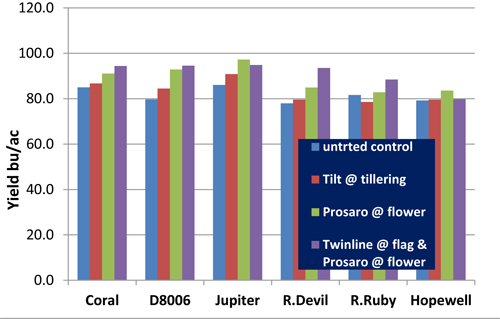Response of winter wheat varieties to fungicide use in 2011
The use of fungicides was beneficial to 2011 wheat yields based on trials conducted this past season. Read on for a summation of the field trial results from Michigan's Thumb region.
For the past few years, the Michigan Crop Improvement Association has supported trials to observe the benefit of fungicides used to help minimize foliar diseases on selected varieties of wheat. The following attempts to summarize the results of this individual study.
The wheat was planted no-till into soybean stubble to accommodate individual plots measuring 15 x 70 feet. The varieties included three soft white winter varieties: Coral, D8006, and Jupiter; and three soft red varieties: Red Devil, Red Ruby and Hopewell. The fungicide treatments, including rates and timing, are listed in Table 1. All applications included a nonionic surfactant.
Table 1. Response of wheat to fungicide treatments, 2011.
| Treatment | Tst wt (lbs/ac) |
Moist % |
Yield (bu/ac) |
Pow.* mildew |
Leaf* spot |
| UTC | 61.8 | 12.9 | 82.3 | 1.2 | 5.6 |
| Tilt 4oz @ tillering | 61.8 | 12.9 | 83.3 | 0.5 | 4.6 |
| Prosaro (6.5 oz) @ flower | 61.5 | 13.4 | 88.7 | 0.0 | 1.5 |
| Twinlne (9oz) @ flag & Prosaro @ flower |
61.5 | 13.5 | 90.9 | 0.0 | 0.8 |
*Disease ratings represent the percent of disease on the flag leaf at early dough
The wheat in the trial area did not exhibit extensive disease development until milk stage. However, by early senescence, diseases including Septoria leaf spot, powdery mildew, Stagonospora leaf blotch, leaf rust, and stem rust could readily be found.
There was considerable variability in the trial area due, in part, to excessive rains during April and May. One replication was considered lost. Therefore, the data only represents two replications and cannot be properly analyzed. Nevertheless, these results are consistent with those of past years.
As summarized in Table 1, the application of Prosaro at flowering boosted yields by six bushels and was the only cost effective treatment under the conditions of this trial. The addition of Twinline prior to the Prosaro application further improved yields, but by only a couple bushels. Applying Tilt at tillering was not effective. Test weights were unaffected by fungicides, while grain moistures tended to be higher in those plots that received the later applications.
Figure 1 illustrates each variety’s yield response to the various fungicide treatments. The responses of the varieties are similar, with the possible exception of Hopewell.
The yield responses are comparable to similar trials conducted over the past three years.



 Print
Print Email
Email
